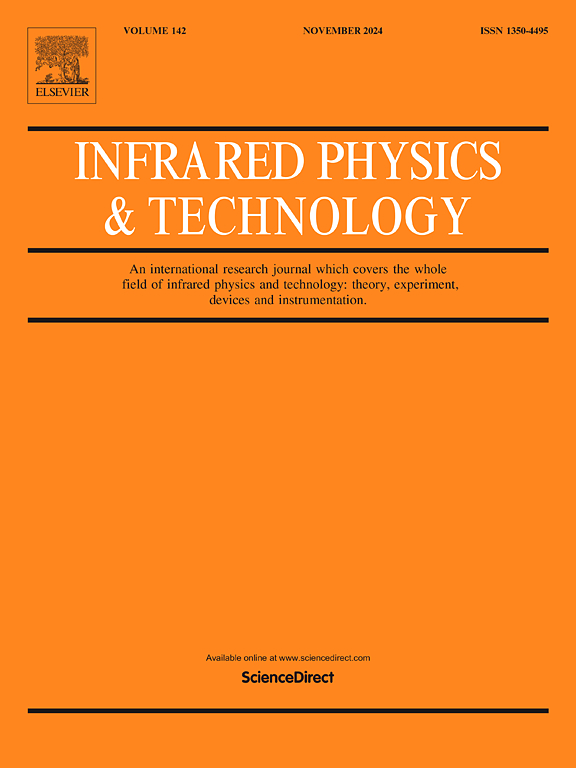Experimental investigation of laser operation in a depressed cladding Tm3+:KY3F10 waveguide laser near 2.3 µm and 1.9 µm
IF 3.1
3区 物理与天体物理
Q2 INSTRUMENTS & INSTRUMENTATION
引用次数: 0
Abstract
We present a detailed investigation of a femtosecond laser written depressed cladding Tm3+:KY3F10 waveguide laser at 2.3 µm and 1.9 μm. Lasing of the Tm3+:KY3F10 channeled waveguide at 2.3 μm was demonstrated for the first time. A circular depressed cladding waveguide with a core diameter of 70 µm was fabricated inside an 8 at. % Tm3+:KY3F10 crystal by femtosecond laser writing. The fabricated waveguide had a measured propagation loss of 0.55 dB/cm and refractive index contrast of 9.5 10-4. Using a Yb-fiber laser operating at 1064 nm as the pump source and a 4 % output coupler, upconversion pumped waveguide laser operation was achieved at 2331 nm with a power slope efficiency of 6.3 %. With a different set of cavity optics and a 33 % output coupler, upconversion pumped waveguide laser operation was also demonstrated near 1.9 µm, where as high as 303 mW of continuous-wave power was generated at 1849 nm with 2 W of pump power and power slope efficiency of 17.7 %. The temporal stability of the waveguide laser was high with a power fluctuation of only 0.2 % over one hour. Passively Q-switched operation was further obtained with a Cr:ZnSe saturable absorber at 1852 nm, giving 110 mW of average output power, power slope efficiency of 6.7 % and pulses as short as 22.4 ns at a pulse repetition rate of 11 kHz, yielding a peak power as high as 448 W.
2.3µm和1.9µm附近抑制包层Tm3+:KY3F10波导激光器操作的实验研究
本文详细研究了2.3 μm和1.9 μm的飞秒激光写入抑制包层Tm3+:KY3F10波导激光器。首次证实了Tm3+:KY3F10通道波导在2.3 μm处的激光效应。在8at内制备了芯径为70 μ m的圆形凹陷包层波导。用飞秒激光写入% Tm3+:KY3F10晶体。该波导的传输损耗为0.55 dB/cm,折射率对比度为9.5 × 10-4。采用工作波长为1064 nm的yb光纤激光器作为泵浦源,采用4%输出耦合器,在2331 nm处实现了上转换泵浦波导激光器的工作,功率斜率效率为6.3%。使用不同的腔光学器件和33%输出耦合器,上转换泵浦波导激光器也在1.9 μ m附近工作,在1849 nm处产生高达303 mW的连续波功率,泵浦功率为2 W,功率斜率效率为17.7%。波导激光器的时间稳定性很高,功率波动在一小时内仅为0.2%。利用Cr:ZnSe可饱和吸收体在1852 nm处实现被动调q操作,平均输出功率为110 mW,功率斜率效率为6.7%,脉冲长度为22.4 ns,脉冲重复率为11 kHz,峰值功率高达448 W。
本文章由计算机程序翻译,如有差异,请以英文原文为准。
求助全文
约1分钟内获得全文
求助全文
来源期刊
CiteScore
5.70
自引率
12.10%
发文量
400
审稿时长
67 days
期刊介绍:
The Journal covers the entire field of infrared physics and technology: theory, experiment, application, devices and instrumentation. Infrared'' is defined as covering the near, mid and far infrared (terahertz) regions from 0.75um (750nm) to 1mm (300GHz.) Submissions in the 300GHz to 100GHz region may be accepted at the editors discretion if their content is relevant to shorter wavelengths. Submissions must be primarily concerned with and directly relevant to this spectral region.
Its core topics can be summarized as the generation, propagation and detection, of infrared radiation; the associated optics, materials and devices; and its use in all fields of science, industry, engineering and medicine.
Infrared techniques occur in many different fields, notably spectroscopy and interferometry; material characterization and processing; atmospheric physics, astronomy and space research. Scientific aspects include lasers, quantum optics, quantum electronics, image processing and semiconductor physics. Some important applications are medical diagnostics and treatment, industrial inspection and environmental monitoring.

 求助内容:
求助内容: 应助结果提醒方式:
应助结果提醒方式:


